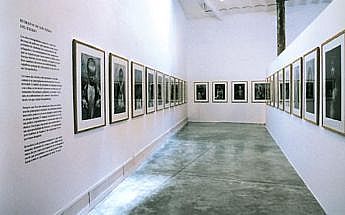|
Vistas de la muestra / Instalation views
| ||
|
Planta Baja / Ground Floor Entrada / Entrance Sala 1 / Room 1 Sala 2 / Room 2 Sala 3 / Room 3 Vista general de planta baja / General view of ground floor |
Primer Piso / First Floor Mesa de lectura / Reading Table Sala 5 / Room 5 Sala 9 / Room 9 Sala 10 / Room 10 |
|
|
Proyecto especial: Salgado en Buenos Aires
Special Project Salgado in Buenos Aires | ||
|
Plaza Italia 1 / Italia Park 1 Plaza Italia 2 / Italia Park 1 Obelisco 1 / Obelisc 1 Obelisco 2 / Obelisc 2 |
Parque Las Heras / Las Heras Park Barrio de Recoleta / Recoleta District |
|
SALA 3
LOS RETRATOS DE LOS NIÑOS DEL EXODO
Los niños fotografiados aquí son como las decenas de millones que pueden verse en los poblados de chozas, los campamentos de refugiados y los asentamientos de campesinos que se esparcen por Latinoamérica, Africa, Asia y Europa; fueron, en ese sentido, escogidos al azar. Pero también detentan una individualidad orgullosa, porque de ellos partió la decisión de ser fotografiados. Un buen día, vieron a un extranjero con una cámara y se precipitaron ruidosamente hacia la novedad. A cambio de permitir al visitante trabajar con calma, se les invitó a ponerse en fila para ser retratados. Su actitud cambiaba de pronto. Uno a uno, se enfrentaban a la cámara y decidían el modo en que serían fotografiados.
Siempre que hay una situación crítica, los niños son las principales víctimas. Son intrínsecamente inocentes, pues no poseen ningún control sobre su propio destino. Y aunque su historia sea la de sus padres, experimentan y narran sus vidas a su manera. Sus ropas, sus poses, sus expresiones y sus ojos nos hablan de tristeza y de sufrimiento, pero también de humor y de esperanza. O eso queremos imaginar. En realidad, sólo podemos imaginar lo que están sintiendo. Al menos, los vemos como eligieron ser vistos. En pie, solos en el universo de la fotografía. Y puede que por primera vez en sus jóvenes vidas hayan tenido la oportunidad de decir "Yo soy".
ROOM 3
THE PORTRAITS OF THE CHILDREN OF THE EXODUS
The photographed children here are as the tens of million that they can deals in the towns of chozas, the refugee camps and the peasant accessions that are scattered by Latin America, Africa, Asia and Europe; were, in that sense, chosen at random. But also they deforce a proud individuality, because they departed the decision of being photographed. A good day, they saw a foreigner with a camera and they were rushed uproariously toward the novelty. In exchange for permitting visitor to work with calm, they were invited to be portrayed. Their attitude changed suddenly. One by one, they were faced to the camera and decided the manner in which they would be photographed.
As long as there is a critical situation, the children are the principal victims. They are intrinsically innocent, since they do not possess no control over their own fate. And though their history will be that of their parents, they experience and narrate their lives in their way. Their clothes, their ways to stand in front of the camera, their expressions and their eyes speak us of sadness and of suffering, but also of humor and of hope. Or we want to imagine that. In reality, only we can imagine what they are feeling. At least, we see them as they decided to be seen. In foot, alone in the universe of the photograph. And it may be that for the first time in their young life they may have had the opportunity of saying "I am".
